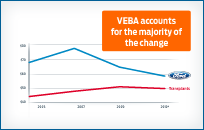Labor Cost Gap
Ford’s Recent History of Hourly Labor Costs
Ford’s average hourly cost per employee for wages and benefits in the U.S. reached about $75 per hour in 2007, prior to the negotiation of a new national contract. By negotiating an agreement with the UAW that year, and by adding modifications in 2009, we were able to substantially improve the competitiveness of our labor costs. Had we not reached this agreement, our average hourly wage rate would have remained simply unsustainable — and utterly uncompetitive — and Ford would not be in a position to create new jobs or bring new work into our U.S. plants.
Labor Cost Gap to Transplants
-
 [1]View large [1]To be fully competitive in the years ahead, we’ll have to close the gap even more.
[1]View large [1]To be fully competitive in the years ahead, we’ll have to close the gap even more.
For example, the savings realized through these two negotiations resulted in the decision to produce two all-new C-car products – the Ford Focus and the next-generation Ford Escape – in its U.S. facilities. The two plants – Michigan Assembly Plant in Wayne, Mich., and the Louisville (Kentucky) Assembly Plant – will employ at least 6,000 hourly employees. If we hadn’t been able to lower our total labor costs, we would have had no choice but to move assembly of these and other products to lower cost labor markets.
There is Still a Gap
And the gap is not only with the transplant companies. We can’t continue to have a gap with the competition — either transplant or domestic — and still make significant U.S. investments and create more jobs. Ford has made significant progress, but the fact remains that a gap still exists. We cannot continue to have a cost gap with the competition and still be able to make significant U.S. investment and create new jobs. For Ford to be fully competitive in the years ahead, we’ll need to focus on closing the gap even more, until we are no longer at a competitive disadvantage in this measure.